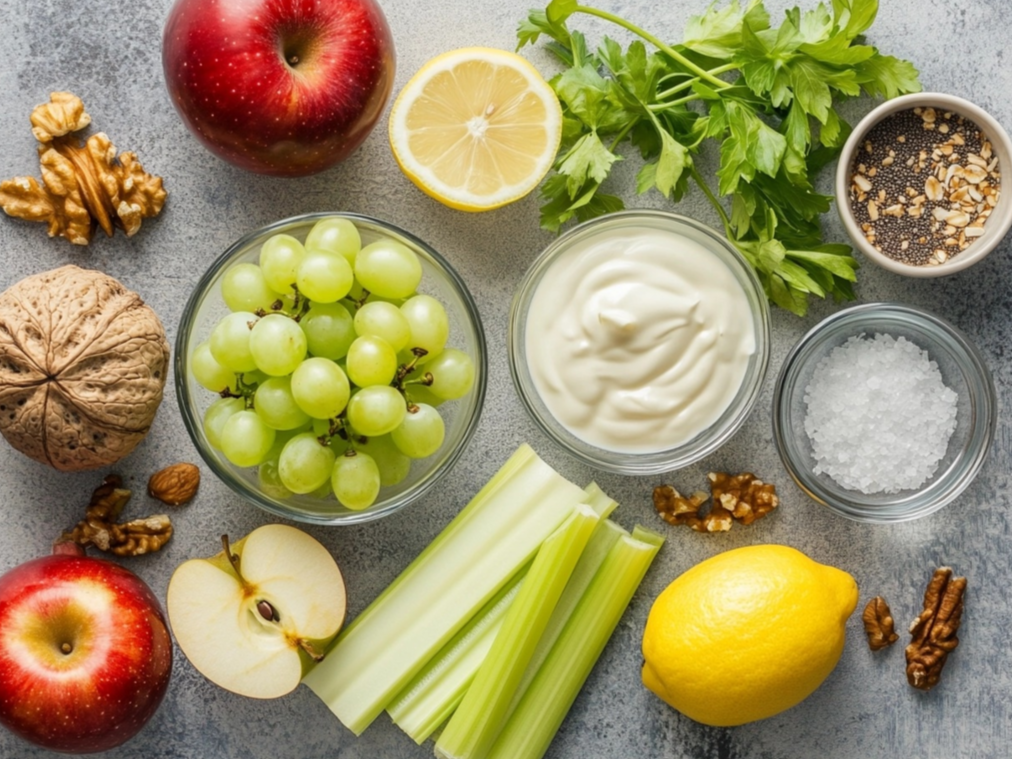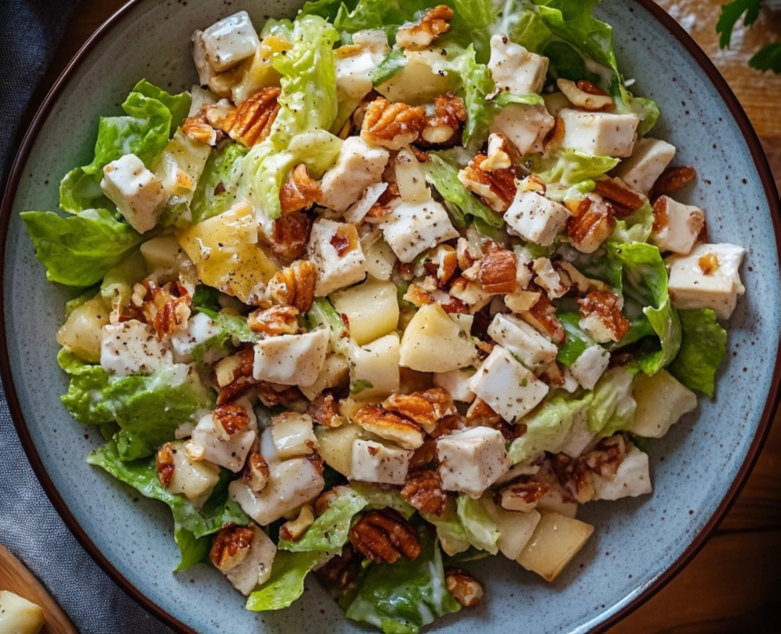This Waldorf Salad is crisp, creamy, and perfect for any gathering.
Introduction to Waldorf Salad
Waldorf Salad offers a timeless blend of flavors and textures that never goes out of style. This iconic dish combines fresh fruit, crunchy nuts, and a creamy dressing, resulting in a refreshing balance of sweet and savory elements. Whether served as a light lunch, a starter before a hearty meal, or a side dish at a festive occasion, it provides an elegant touch to any table. Moreover, its simple preparation and flexible ingredients make customization easy. In this comprehensive guide, you’ll discover how to create, adapt, and serve the Waldorf Salad while enhancing its flavors and staying true to its roots.
Benefits of Waldorf Salad
Incorporating Waldorf Salad into your meal plan offers several benefits. Not only is it visually appealing, but it also provides significant nutritional value. The blend of crisp apples, juicy grapes, crunchy celery, and creamy dressing delivers essential vitamins, fiber, and healthy fats. Additionally, its natural sweetness helps satisfy cravings without relying on overly processed sweets. Furthermore, the simplicity of this dish allows for modifications based on dietary needs, ensuring it easily fits into a balanced eating pattern.
Nutritional Advantages
Waldorf Salad is typically rich in nutrients that support overall health. Apples contribute fiber and vitamin C, while grapes offer antioxidants and natural sweetness. Celery adds crunch, minerals, and dietary fiber, aiding digestion. Often, the salad includes walnuts or pecans, which provide healthy fats, protein, and micronutrients. By choosing a lighter dressing or a yogurt-based option, you can reduce saturated fats and sugars, making Waldorf Salad a more health-conscious choice. Consequently, enjoying Waldorf Salad can help maintain energy levels, support gut health, and offer long-lasting satiety.
Versatility and Ease of Preparation
One of the key appeals of Waldorf Salad is its versatility. This classic dish can be adapted to suit various dietary requirements and taste preferences. For example, you can substitute certain fruits, add extra vegetables, or choose a dairy-free dressing. Additionally, making the salad is straightforward, requiring basic kitchen skills and minimal cooking time. Because of its simplicity, it’s an excellent option for busy individuals seeking a quick and nourishing meal. Whether you’re hosting a brunch, packing a picnic, or preparing a simple family dinner, it can easily fit your schedule and culinary goals.
Cultural and Culinary Heritage
Waldorf Salad originated in the late 19th century at the Waldorf-Astoria Hotel in New York City. Initially made with apples, celery, and mayonnaise, it soon gained popularity and evolved over time. Today, countless variations incorporate grapes, nuts, and different dressings. Despite these changes, Waldorf Salad retains its reputation as a classic American dish cherished for its elegance and simplicity. This cultural heritage makes Waldorf Salad a conversation piece, adding a sense of tradition and nostalgia to your table.
Essential Ingredients for Waldorf Salad

Creating a delicious Waldorf Salad starts with selecting the right ingredients. Waldorf Salad relies on high-quality fruits, crisp celery, and a creamy dressing to achieve its signature flavor and texture.
- Apples: Crisp, slightly tart apples like Granny Smith or Honeycrisp.
- Grapes: Seedless red or green grapes for sweetness and juiciness.
- Celery: Fresh, crunchy celery stalks add crisp texture.
- Nuts: Walnuts or pecans provide richness and a subtle earthy flavor.
- Dressing: A creamy base, traditionally mayonnaise, often lightened with yogurt or sour cream.
- Lemon Juice: For brightness and to prevent apple browning.
- Salt and Pepper: To season and enhance flavors.
Selecting the Best Produce
Fresh, high-quality produce is crucial for making Waldorf Salad. Waldorf Salad benefits from apples that maintain their crispness and flavor after cutting, ensuring the salad doesn’t turn mushy. Likewise, choose grapes that are firm, sweet, and fragrant. In addition, opt for celery that’s bright and free of blemishes. Finally, ensure your nuts are fresh and unsalted, preserving the dish’s natural sweetness and balance. Consequently, investing in top-notch ingredients enhances the overall taste and presentation.
Choosing the Right Dressing
While the classic Waldorf Salad dressing often uses mayonnaise, you can experiment with alternatives. Waldorf Salad can incorporate Greek yogurt or a blend of yogurt and mayo for a lighter, tangier taste. Some prefer sour cream or a vinaigrette for a more refreshing twist. Adjusting the dressing’s richness and sweetness lets you tailor the salad to personal preferences. Thus, focusing on your ideal dressing style contributes significantly to achieving your perfect Waldorf Salad.
Step-by-Step Guide to Making Waldorf Salad
Crafting the perfect Waldorf Salad is simple if you follow a few essential steps. By carefully preparing and combining ingredients, you’ll produce a dish that’s both visually appealing and mouthwatering.
1. Prepare the Ingredients
Start by washing and drying all produce thoroughly. Cut the apples into bite-sized cubes, leaving the skin on for added fiber and color. Halve or quarter the grapes, depending on their size. Slice the celery thinly to maintain crunch. Meanwhile, chop the nuts coarsely, ensuring they add texture without overpowering the dish.
2. Toss with Lemon Juice
Place the chopped apples in a bowl and toss them with a splash of lemon juice. This step prevents browning and adds a subtle brightness to the Waldorf Salad. Doing so ensures the apples maintain their crisp appearance and fresh taste, even if the salad sits for a while before serving.
3. Combine Fruits and Vegetables
Add the grapes and celery to the apples, gently mixing them to distribute the colors and textures evenly. This combination forms the core of your Waldorf Salad, providing the signature balance of sweet, crunchy, and juicy components. Take care when stirring to preserve the fruits’ shape and prevent bruising.
4. Prepare the Dressing
In a separate bowl, whisk together your chosen dressing base, whether it’s mayo, yogurt, sour cream, or a blend. Season with salt, pepper, and a pinch of sugar if desired. Taste and adjust accordingly—add more lemon juice for brightness or a bit more sweetener if needed. Remember that the dressing should complement, not overwhelm, the ingredients in your Waldorf Salad.
5. Mix the Salad Gently
Pour the dressing over the fruit and vegetable mixture, folding gently to ensure even coating. Avoid over-mixing, which can cause the fruits to release excess juices, watering down the dressing. The goal is a creamy, well-balanced consistency that clings to each piece.
6. Add Nuts and Final Touches
Sprinkle the chopped nuts over the salad, adding a toasty crunch that contrasts with the creamy dressing and juicy fruits. Consider adding fresh herbs like parsley or chives for a subtle herbal note. Taste once more and adjust seasoning as necessary. If the salad lacks complexity, consider an additional squeeze of lemon or a pinch of salt.
7. Chill and Serve
Cover the Waldorf Salad and refrigerate it for at least 30 minutes, allowing flavors to meld. The chilling period helps the dressing infuse every component, resulting in a more cohesive taste experience. Before serving, give the salad a gentle stir and transfer it to a stylish bowl. Garnish with a few extra nuts and herbs for a polished presentation.

Popular Variations of Waldorf Salad
Waldorf Salad is infinitely adaptable, letting you experiment with unique combinations that suit various tastes. thesSalad variations may incorporate different fruits, add proteins, or substitute dressings for personalized twists.
Waldorf Salad with Pears
Substitute pears for half of the apples to introduce another layer of sweetness and texture. Pears bring a delicate floral note that complements the creaminess of the dressing. This variation on Waldorf Salad is especially delightful during pear season, adding complexity and interest.
Waldorf Salad with Chicken
Turn Waldorf Salad into a more substantial main dish by adding cooked chicken breast. Shred or cube the chicken and toss it with the other ingredients. This addition makes the salad heartier and suitable for lunches or light dinners. The protein component also provides sustained energy and a savory note that contrasts nicely with the fruits.
Waldorf Salad with Yogurt Dressing
Replace the mayonnaise in Waldorf Salad with Greek yogurt for a lighter, tangier dressing. Greek yogurt adds creaminess and protein without as much richness. Adjust the seasoning accordingly and consider adding a bit of honey or maple syrup to balance the yogurt’s tanginess. The result is a fresher, lighter version that still satisfies cravings for creamy textures.
Waldorf Salad with Exotic Fruits and Nuts
Shake things up by adding exotic fruits like pomegranate seeds or dried cherries to Waldorf Salad. Pine nuts or pistachios instead of walnuts or pecans introduce new flavor dimensions. Such choices open the door to endless creativity, allowing you to design a Waldorf Salad that suits your adventurous palate.
Waldorf Salad with Herbs and Spices
Introduce subtle herbs and spices to your Waldorf Salad to create a more sophisticated flavor profile. A hint of dried tarragon or fresh mint can transform the dish. A pinch of cayenne or paprika adds warmth, while a drizzle of high-quality olive oil enhances the overall richness. Experimenting with these elements ensures that your Waldorf Salad remains fresh and interesting.
Tips and Tricks for Perfect Waldorf Salad
To ensure your Waldorf Salad turns out beautifully every time, consider these helpful tips and tricks.
1. Use Fresh, Quality Ingredients
Quality is key. Choose crisp apples, firm grapes, and vibrant celery. High-quality produce enhances both flavor and appearance, resulting in a better-tasting Waldorf Salad.
2. Balance Sweetness and Tartness
If your Waldorf Salad tastes too sweet, add more lemon juice or a pinch of salt. Conversely, if it’s too tangy, add a bit of sweetener or extra grapes. Achieving the right balance ensures a delightful eating experience.
3. Keep it Cool
Chilling the Waldorf Salad before serving helps the flavors meld and the dressing set. Don’t skip this step, as it can significantly improve the dish’s texture and taste.
4. Adjust to Dietary Needs
Waldorf Salad can easily adapt to various dietary restrictions. For instance, use vegan mayo or a dairy-free yogurt if avoiding animal products. If you’re watching carbs or sugars, reduce the fruit proportion or choose a sugar-free sweetener. The salad’s flexibility lets you cater to many lifestyles.
5. Pair with Complementary Dishes
Serve Waldorf Salad alongside savory entrées or lighter fare. For example, enjoy it with a simple grilled fish, roasted chicken, or even try it with Zucchini Pasta to add a refreshing contrast. The combination of crunchy salad and silky pasta can create a well-rounded, memorable meal.
6. Store Leftovers Properly
If you have leftovers, store them in an airtight container in the refrigerator. While Waldorf Salad is best enjoyed fresh, it can still taste great for up to a day or two afterward. However, the apples may soften and the nuts may lose crispness, so plan to consume it promptly for the best quality.
7. Experiment with Ratios
Feel free to adjust the apple-to-celery or fruit-to-nut ratios to suit your taste. Some prefer more crunch from celery, while others crave extra sweetness from grapes. This flexibility lets you create a Waldorf Salad that perfectly aligns with your preferences.
Frequently Asked Questions
What does a Waldorf salad contain?
A Waldorf Salad traditionally contains apples, celery, and mayonnaise, often accompanied by grapes and nuts. Over time, the recipe gradually evolved to include toasted walnuts or pecans. Many variations now exist, incorporating dried fruits, fresh herbs, and lighter dressings like yogurt. Moreover, the core concept remains a balance of sweet, crunchy, and creamy elements in every bite.
What country is Waldorf salad from?
Waldorf Salad originated in the United States. It was first created at the Waldorf-Astoria Hotel in New York City during the late 19th century. Initially introduced as a simple apple-celery-mayo combination, it has since become an iconic American dish, beloved worldwide.
What is the three sacred sisters salad?
The “three sisters” in culinary tradition usually refer to corn, beans, and squash grown together by Indigenous peoples in North America. While not directly related to Waldorf Salad, the concept of three sisters salad involves combining these staple crops. Waldorf Salad, on the other hand, focuses on apples, celery, and grapes or nuts. They represent different cultural and agricultural traditions.
What is the most popular salad in the world?
Determining the most popular salad globally can be subjective and depends on region and tradition. However, some widely recognized salads include Caesar salad, Greek salad, and Caprese salad. While Waldorf Salad may not claim the top spot in worldwide popularity, it remains a cherished American classic that has earned its place among iconic salads recognized for their timeless appeal and cultural significance.
Conclusion
Waldorf Salad stands as a timeless favorite that marries simplicity, flavor, and versatility. From its inception at the Waldorf-Astoria to the countless variations enjoyed today, Waldorf Salad continues to captivate food lovers. By choosing fresh, quality ingredients and balancing flavors to personal taste, you can create a version that perfectly suits your needs. Additionally, pairing it with complementary dishes or customizing it for dietary requirements ensures Waldorf Salad fits into any meal plan. Embrace the tradition and creativity inherent in Waldorf Salad, and enjoy its delightful textures and refreshing taste for years to come.

